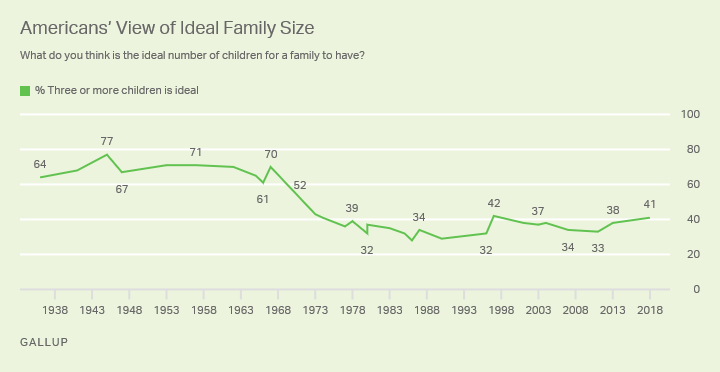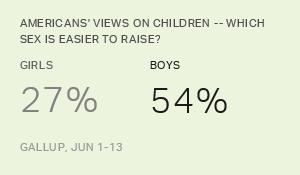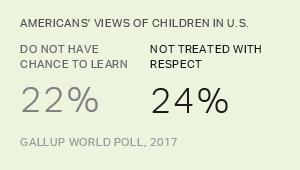Story Highlights
- Four in 10 Americans now say three or more children is ideal family size
- Preference for three-plus children is up from 33% in 2007
- Increase mainly in preference for four or more children
WASHINGTON, D.C. -- Despite declining U.S. birth rates since the 2007-2009 recession, Americans' views on ideal family size are moving in the other direction. Currently, 41% of U.S. adults think that families of three or more children is ideal. That is up from 38% in 2013 and 34% in 2011, and is the highest Gallup has seen on this measure since 1997 -- although it is well below the 77% high point in 1945.

While 41% currently say three or more children is ideal, 50% say one or two is best while just 1% say zero. These data broadly align with previous Gallup research finding most U.S. adults aged 18 to 40 hoping to be parents someday, if they are not already.
Americans' views about ideal family size have changed markedly since Gallup first probed the topic in 1936. From then through the late 1960s, more than six in 10 adults thought that having three or more children was ideal, with the figure rising to 77% in 1945, at the end of World War II and start of the Baby Boom.
Gallup documented a particularly abrupt change between 1967 and its next measure in 1971, as the percentage favoring large families fell from 70% to 52%. This may have reflected public fears of a global population explosion, as detailed in the bestselling 1968 book "The Population Bomb." Major societal changes at that time around the role of women may also have been a factor.
Preferences for large families continued to wane through the 1970s and 1980s, spanning three U.S. recessions, and reached a low of 28% in 1986. It has since fluctuated, but reached a recent high of 42% in 1997 amid a booming economy and a low of 33% in 2011 as the country was still recovering from the 2007 to 2009 recession.
The average number of children U.S. adults think is ideal is now 2.7, up slightly from 2.5 in 2007 and 2011.
Meanwhile, U.S. fertility reportedly reached a record-low 60.2 births per 1,000 women in 2017 -- about half its level during the peak Baby Boom year of 1957 -- and followed a fairly steady decline from 69.3 births per 1,000 women in 2007.
Higher Income, College Educated Think Fewer Children Is Ideal
The new poll, conducted June 1-13, finds relatively slight differences in attitudes about ideal family size by gender and age, largely consistent with readings in recent years. The similarity by age, with the youngest and oldest Americans equally likely to believe three or more children is best, is particularly notable given declining birth rates. This may suggest that young people without children may intend to delay starting families, not forego having children altogether.
At the same time, adults with lower income and education levels, as well as Republicans, are more likely than their counterparts to say having three or more children is ideal.
| 2007 | 2011 | 2013 | 2018 | ||||||||||||||||||||||||||||||||||||||||||||||||||||||||||||||||||||||||||||||||||||||||||||||||
|---|---|---|---|---|---|---|---|---|---|---|---|---|---|---|---|---|---|---|---|---|---|---|---|---|---|---|---|---|---|---|---|---|---|---|---|---|---|---|---|---|---|---|---|---|---|---|---|---|---|---|---|---|---|---|---|---|---|---|---|---|---|---|---|---|---|---|---|---|---|---|---|---|---|---|---|---|---|---|---|---|---|---|---|---|---|---|---|---|---|---|---|---|---|---|---|---|---|---|---|
| % | % | % | % | ||||||||||||||||||||||||||||||||||||||||||||||||||||||||||||||||||||||||||||||||||||||||||||||||
| Men | 33 | 41 | 36 | 43 | |||||||||||||||||||||||||||||||||||||||||||||||||||||||||||||||||||||||||||||||||||||||||||||||
| Women | 35 | 43 | 38 | 38 | |||||||||||||||||||||||||||||||||||||||||||||||||||||||||||||||||||||||||||||||||||||||||||||||
| 18 to 34 | 44 | 43 | 46 | 45 | |||||||||||||||||||||||||||||||||||||||||||||||||||||||||||||||||||||||||||||||||||||||||||||||
| 35 to 54 | 29 | 42 | 36 | 36 | |||||||||||||||||||||||||||||||||||||||||||||||||||||||||||||||||||||||||||||||||||||||||||||||
| 55+ | 34 | 40 | 32 | 44 | |||||||||||||||||||||||||||||||||||||||||||||||||||||||||||||||||||||||||||||||||||||||||||||||
| Post graduate | 31 | 31 | 30 | 36 | |||||||||||||||||||||||||||||||||||||||||||||||||||||||||||||||||||||||||||||||||||||||||||||||
| College grad only | 37 | 26 | 33 | 36 | |||||||||||||||||||||||||||||||||||||||||||||||||||||||||||||||||||||||||||||||||||||||||||||||
| Some college | 33 | 33 | 34 | 40 | |||||||||||||||||||||||||||||||||||||||||||||||||||||||||||||||||||||||||||||||||||||||||||||||
| No college | 34 | 37 | 43 | 46 | |||||||||||||||||||||||||||||||||||||||||||||||||||||||||||||||||||||||||||||||||||||||||||||||
| $75,000 and over | 30 | 33 | 32 | 38 | |||||||||||||||||||||||||||||||||||||||||||||||||||||||||||||||||||||||||||||||||||||||||||||||
| $30,000-$74,999 | 36 | 44 | 35 | 40 | |||||||||||||||||||||||||||||||||||||||||||||||||||||||||||||||||||||||||||||||||||||||||||||||
| Less than $30,000 | 39 | 44 | 43 | 49 | |||||||||||||||||||||||||||||||||||||||||||||||||||||||||||||||||||||||||||||||||||||||||||||||
| Republicans | 42 | 50 | 38 | 45 | |||||||||||||||||||||||||||||||||||||||||||||||||||||||||||||||||||||||||||||||||||||||||||||||
| Independents | 29 | 39 | 37 | 42 | |||||||||||||||||||||||||||||||||||||||||||||||||||||||||||||||||||||||||||||||||||||||||||||||
| Democrats | 34 | 35 | 36 | 37 | |||||||||||||||||||||||||||||||||||||||||||||||||||||||||||||||||||||||||||||||||||||||||||||||
| Gallup | |||||||||||||||||||||||||||||||||||||||||||||||||||||||||||||||||||||||||||||||||||||||||||||||||||
Desire for Big Families Pushes Average Higher
The increase since 2007 in the average number of children Americans prefer can be explained mainly by an increase in the proportion of adults who think four or more children is ideal -- this rose from 9% in 2007 to 15% today.
Meanwhile, the percentage seeing three children as ideal has been fairly steady near 25%, and there has been no change in the percentage favoring one or no children.
| 2007 | 2011 | 2013 | 2018 | ||||||||||||||||||||||||||||||||||||||||||||||||||||||||||||||||||||||||||||||||||||||||||||||||
|---|---|---|---|---|---|---|---|---|---|---|---|---|---|---|---|---|---|---|---|---|---|---|---|---|---|---|---|---|---|---|---|---|---|---|---|---|---|---|---|---|---|---|---|---|---|---|---|---|---|---|---|---|---|---|---|---|---|---|---|---|---|---|---|---|---|---|---|---|---|---|---|---|---|---|---|---|---|---|---|---|---|---|---|---|---|---|---|---|---|---|---|---|---|---|---|---|---|---|---|
| % | % | % | % | ||||||||||||||||||||||||||||||||||||||||||||||||||||||||||||||||||||||||||||||||||||||||||||||||
| 4 or more children | 9 | 10 | 13 | 15 | |||||||||||||||||||||||||||||||||||||||||||||||||||||||||||||||||||||||||||||||||||||||||||||||
| 3 children | 25 | 23 | 25 | 26 | |||||||||||||||||||||||||||||||||||||||||||||||||||||||||||||||||||||||||||||||||||||||||||||||
| 2 children | 52 | 53 | 48 | 47 | |||||||||||||||||||||||||||||||||||||||||||||||||||||||||||||||||||||||||||||||||||||||||||||||
| Zero, or 1 child | 4 | 5 | 5 | 4 | |||||||||||||||||||||||||||||||||||||||||||||||||||||||||||||||||||||||||||||||||||||||||||||||
| Gallup | |||||||||||||||||||||||||||||||||||||||||||||||||||||||||||||||||||||||||||||||||||||||||||||||||||
Bottom Line
Following a long-term decline in the U.S. birth rate since the Baby Boom era, the drop in U.S. birth rates over the past decade is especially notable because it has persisted long after the 2007-2009 recession ended. Should it continue, the economic implications for the U.S. would be enormous, and intersect with U.S. immigration policy, as the relatively young immigrant population could be vital to maintaining economic growth and keeping the Social Security system viable.
Researchers have explored a variety of economic and cultural reasons for declining birth rates: the expense of having and raising a child, the effect of motherhood on women's incomes, shifting priorities as people progress in their careers, women's lower fertility as they age, and a desire to postpone or avoid the responsibilities of parenthood. While all of these factors may play a role, one thing seems clear from the Gallup data -- Americans, including young people, still embrace the idea of multiple children making for an "ideal" family. Whether they ever strive for that ideal in their own lives is a different question.
Survey Methods
Results for this Gallup poll are based on telephone interviews conducted August 1-6, 2018, with a random sample of 1,017 adults, aged 18 and older, living in all 50 U.S. states and the District of Columbia. For results based on the total sample of national adults, the margin of sampling error is ±4 percentage points at the 95% confidence level. All reported margins of sampling error include computed design effects for weighting.
Each sample of national adults includes a minimum quota of 70% cellphone respondents and 30% landline respondents, with additional minimum quotas by time zone within region. Landline and cellular telephone numbers are selected using random-digit-dial methods.
[View survey methodology, complete question responses and trends.]
Learn more about how the Gallup Poll Social Series works.




